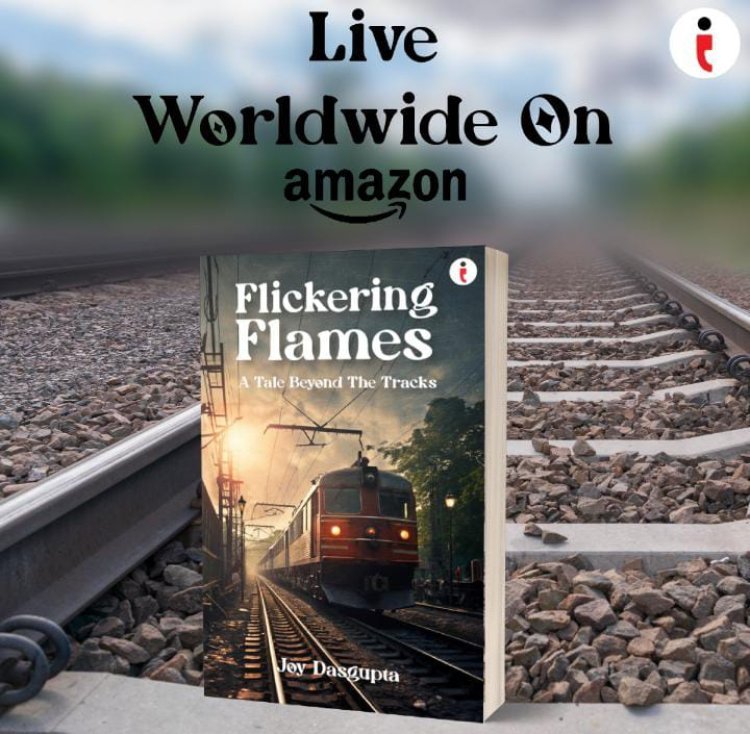Flickering Flames: A Chance Encounter, A Rekindled Passion, A Journey of Fate" by Joy Dasgupta

- What prompted you to write this particular book, and how did the story idea come to you?
Locked within the confines of four walls for an extended period during the COVID-19 pandemic, filled me with strokes of despondency. The deflating news broadcasts that bombarded the eardrums were unnerving and fearful—as a gateway, I resorted to binge-watching on OTT platforms which pushed me into the banks of creative thinking. Writing, a long-time passion, was a logical refuge for me, loaded with ideas. A few casual scribbles outlining a romantic dalliance brought out the concept of the story. Encouraged by friends and family during group chats on social media platforms, the creative bug engaged the mind in the development of a compelling plot.
- Can you tell us about your writing process? Do you follow any specific routine or rituals to get into the creative zone?
As the night gets quieter and the mind gets uncluttered with a sharpened focus, I find creative writing flows easily. Allowing ideas to develop organically at first without worrying about refinement, dialogue, and pacing is essential. Writing in the same rhythm as the thoughts occur adds raw flavor, and spontaneity and keeps the momentum going. Editing and perfection are prioritized only after the first draft. - Your book features distinct and memorable characters. Were they inspired by real people, or did they emerge purely from your imagination?
The main players of the plot are figments of imagination, though they bear shades of resemblances to the characters who have dominated my world since childhood.
- The book explores [specific theme or issue]. What led you to choose this theme, and what do you hope readers will take away from it?
Many philosophies and spiritual traditions believe destiny represents a preordained set of events or outcomes that are influenced by factors beyond our control. The role of destiny in our lives is often seen as the unknown force that shapes or guides the path we take, with our choices, actions, and free will being limited within a restricted framework. To unearth the balance between fate and free will is the key to understanding life’s journey.
- The world-building in your novel is detailed and immersive. How did you create the setting, and were there any real-world locations or historical events that inspired it?
The book is a work of fiction with the setting primarily in Central India. World-building was therefore laid out with an eye on the physical environment, culture, language, customs, religion, and social structures that influence the way characters interact with one another and their world.
- As a writer, how do you balance the need for originality with the expectations of the genre? Were there any challenges in giving a fresh perspective to familiar themes?
The genre of the book is romantic fiction. Emotional outpouring is a strong driving force behind the story intertwined with relatability. When creative flow encapsulates emotions like love, joy, anger, grief, etc., the tone, direction, and character development in this genre become more impactful. Familiar themes like love, romance, and redemption have been explored repeatedly. Adding novelty to the plot structure without deviating too much from readers' expectations was challenging.
- The pacing in your story is well-crafted, keeping the readers engaged. What’s your approach to maintaining tension and momentum throughout the narrative?
The love story flows through thirty years. It was crucial to keep the readers engaged, balancing between their past and the present narrative. The reflective sections were interjected with the current storyline subtly to avoid monotony and detachment. Weaving subplots, interlacing dialogue and description, and sprinkling emotional beats had to be meticulously crafted to maintain tension as well as the reader's interest throughout the novel.
- In today’s rapidly changing media landscape and evolving reader preferences, how do you see traditional storytelling adapting? And how do you adjust your writing to connect with modern audiences?
Traditional storytelling has primarily depended on strategies like emotionally charged universal themes, well-developed narratives, and compelling, relatable characters. Readers of today, however, expect multifaceted, nuanced characters that are rooted in the current setting. These days, non-linear narratives with flashbacks, broken timelines, and implied morality are very popular. Flickering Flames is overtly contemporary in its narration and strikes a balance by using traditional story elements while incorporating new techniques like nonlinear narrative and layers of realism.
-Buy your copy of Flickering Flames now and experience the journey of a lifetime.

 brandmakerrd@gmail.com
brandmakerrd@gmail.com 















